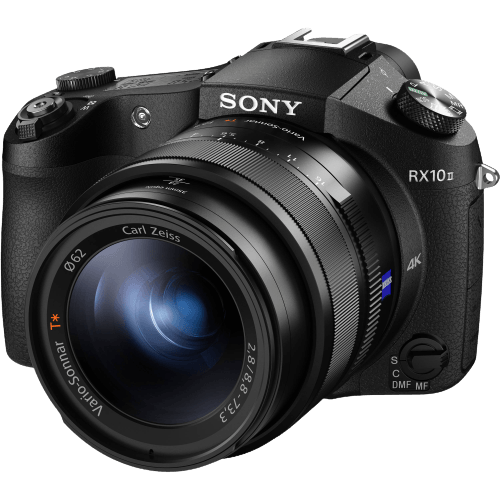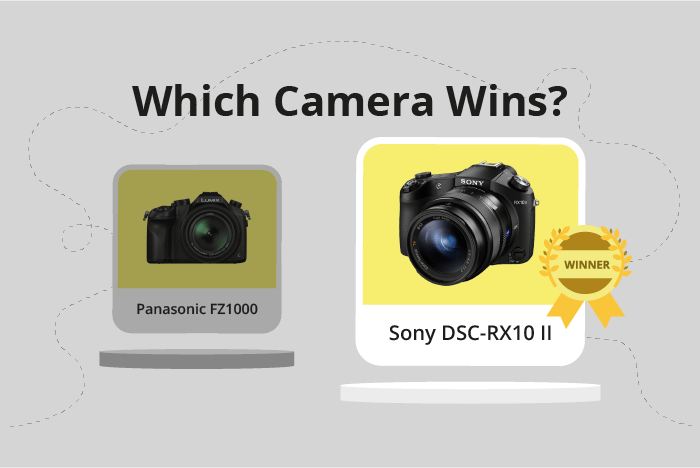Panasonic Lumix DMC-FZ1000 vs Sony Cyber-shot DSC-RX10 II Comparison
Panasonic Lumix DMC-FZ1000

Sony Cyber-shot DSC-RX10 II

The Sony Cyber-shot DSC-RX10 II outperforms the Panasonic Lumix DMC-FZ1000 with a score of 59/100 compared to 57/100. Both cameras are bridge cameras, sharing common features like launch year (2014 for Panasonic and 2015 for Sony) and similar size and weight. However, the Sony RX10 II has an edge over the Panasonic FZ1000 with its higher launch price of $1,299, suggesting better overall quality.
The Panasonic Lumix DMC-FZ1000, priced at $899, is more budget-friendly, making it a more accessible option for many consumers. Its size and weight (137 x 99 x 131mm and 831g) are only slightly larger and heavier than the Sony RX10 II (129 x 88 x 102mm and 813g).
While both cameras have their advantages, the Sony Cyber-shot DSC-RX10 II’s higher score indicates it is a better camera overall. However, the Panasonic Lumix DMC-FZ1000 could be a more suitable choice for those seeking a more affordable option without sacrificing too much in terms of quality and performance.
Panasonic Lumix DMC-FZ1000 vs Sony Cyber-shot DSC-RX10 II Overview and Optics
The Sony Cyber-shot DSC-RX10 II wins in the optics comparison with a score of 64/100, a three-point difference from the Panasonic Lumix DMC-FZ1000’s score of 61/100. Both cameras share some common specifications, such as the 20-megapixel resolution, CMOS sensor type, 1″ sensor size, fixed lens mount, and image stabilization.
The Sony Cyber-shot DSC-RX10 II stands out with its faster shooting speed of 14 frames per second (fps) compared to the Panasonic Lumix DMC-FZ1000’s 12 fps. Additionally, the Sony camera has a higher DXOMARK score for the sensor at 70, compared to Panasonic’s 64. This indicates that the Sony camera has better image quality and performance.
On the other hand, the Panasonic Lumix DMC-FZ1000 has a Venus Engine processor, while the Sony Cyber-shot DSC-RX10 II uses a Bionz X processor. Although both processors are efficient, there is no clear winner in this aspect as the choice depends on the user’s preference.
In terms of optics, the Sony Cyber-shot DSC-RX10 II outperforms the Panasonic Lumix DMC-FZ1000 with a faster shooting speed and a better DXOMARK score for the sensor. However, both cameras offer similar specifications in other areas, making them both suitable options for users. The choice ultimately depends on the user’s specific needs and preferences, with the Sony camera being the better option for those who prioritize faster shooting speeds and higher image quality.
Panasonic Lumix DMC-FZ1000 vs Sony Cyber-shot DSC-RX10 II Video Performance
The Panasonic Lumix DMC-FZ1000 takes the lead in video capabilities with a score of 83/100, while the Sony Cyber-shot DSC-RX10 II follows closely with a score of 77/100. Both cameras share some common specifications, such as 4K max video resolution and 3840 x 2160 max video dimensions.
The Panasonic Lumix DMC-FZ1000 outperforms the Sony Cyber-shot DSC-RX10 II in certain aspects. It has a built-in time-lapse functionality, which the Sony Cyber-shot DSC-RX10 II lacks. This feature allows users to create stunning time-lapse videos without the need for additional software or hardware. Furthermore, the Panasonic Lumix DMC-FZ1000 has a max video frame rate of 60fps, which is sufficient for most users and delivers smooth video playback.
On the other hand, the Sony Cyber-shot DSC-RX10 II excels in its max video frame rate of 120fps. This higher frame rate enables users to capture slow-motion videos with greater detail and smoothness. However, the absence of built-in time-lapse functionality in the Sony Cyber-shot DSC-RX10 II may be a drawback for some users.
Taking into account the video capabilities of both cameras, the Panasonic Lumix DMC-FZ1000 proves to be a more versatile option with its built-in time-lapse functionality and a satisfactory max video frame rate of 60fps. Meanwhile, the Sony Cyber-shot DSC-RX10 II is better suited for users who prioritize slow-motion video capture with its impressive 120fps max video frame rate. Ultimately, the choice between the two cameras depends on individual preferences and specific video requirements.
Panasonic Lumix DMC-FZ1000 vs Sony Cyber-shot DSC-RX10 II Features and Benefits
The Panasonic Lumix DMC-FZ1000 outperforms the Sony Cyber-shot DSC-RX10 II in features with a score of 58/100, while the Sony camera scores 57/100. Both cameras have common specifications like a 3-inch screen, no touchscreen, no GPS, WIFI, and Bluetooth connectivity.
The Lumix DMC-FZ1000 has a higher screen resolution of 2,359,000 dots compared to the RX10 II’s 1,228,800 dots. This means the FZ1000 provides a clearer and more detailed view of the images on the screen. Additionally, the FZ1000 has a flip screen, allowing for more versatile shooting angles and easier self-portraits. This feature is not available in the RX10 II.
On the other hand, the Sony RX10 II does not have any notable advantages over the Panasonic FZ1000 in terms of features. Both cameras have the same screen size and lack a touchscreen, GPS, and have the same connectivity options.
In comparing the features of these two cameras, the Panasonic Lumix DMC-FZ1000 is the better choice due to its higher screen resolution and the presence of a flip screen. The Sony Cyber-shot DSC-RX10 II does not offer any unique advantages over the FZ1000 in this aspect. The one-point difference in the scores illustrates that the FZ1000 has a slight edge over the RX10 II in terms of features.
Panasonic Lumix DMC-FZ1000 vs Sony Cyber-shot DSC-RX10 II Storage and Battery
The Sony Cyber-shot DSC-RX10 II outperforms the Panasonic Lumix DMC-FZ1000 in storage and battery, scoring 24/100 compared to the Panasonic’s 21/100. Both cameras have one memory card slot and accept SD, SDHC, and SDXC cards. The Sony camera also supports Memory Stick Duo, Pro Duo, and Pro-HG Duo cards, providing more storage options.
The Sony Cyber-shot DSC-RX10 II has a longer battery life, providing 400 shots compared to the Panasonic’s 360 shots. Both cameras use different battery types, with the Sony using NP-FW50 and the Panasonic using DMW-BLC12PP. Neither camera offers USB charging capabilities.
Although the Panasonic Lumix DMC-FZ1000 falls short in storage and battery performance, it still provides a decent battery life and storage options. The Sony Cyber-shot DSC-RX10 II, however, offers better battery life and more diverse storage options, making it the superior choice in this aspect.
Panasonic Lumix DMC-FZ1000 vs Sony Cyber-shot DSC-RX10 II – Our Verdict
Are you still undecided about which camera is right for you? Have a look at these popular comparisons that feature the Panasonic Lumix DMC-FZ1000 or the Sony Cyber-shot DSC-RX10 II:

